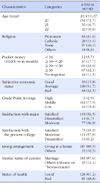Abstract
Purpose
The purpose of this study was to investigate factors related to happiness in first year women nursing students.
Methods
The sample consisted of 209 first year women nursing students in three colleges located in S and C cities. Data were collected during October and November 2011. The major variables for this study were depression, self-esteem, optimism, interpersonal relation, and happiness. Data were analyzed using descriptive analysis, independent t-test, one-way ANOVA, correlation coefficient, and multiple stepwise regression with SPSS/WIN 17.0.
Results
There were significant differences in student happiness according to economic status, satisfaction with major, satisfaction with the present college, and health status. Happiness was significantly correlated with depression, self-esteem, optimism, and interpersonal relations. Self-esteem, optimism, interpersonal relations, and satisfaction with major were significant predictors of happiness for first year women nursing students and these four factors accounted for 71% of the variance in happiness.
Figures and Tables
References
1. Bae GI. Korean 'quality of life'. dongA.com. 2011. 08. 22. Retrieved October 13, 2011. from http://news.donga.com/3/all/20110821/39699364/1.
2. Beck AT. The Beck Depression Inventory. 1978. Philadelphia: Center for Cognitive Therapy.
3. Chang EC, Maydeu-Oilvares A, D'Zurilla TJ. Optimism and pessimism as partially independent constructs: Relationship to positive and negative affectivity and psychological well-being. Pers Individ Dif. 1997. 23:433–440.

4. Choi MO. The study of comparing the factors affecting male and female happiness-focusing on the city of Busan. Soc Sci Res Rev. 2011. 27:19–40.

5. Choi YW, Lee SJ. The influence of individual differences in emotional awareness on mental health of college students. Korean J Health Psychol. 2004. 9:887–901.
6. Cloninger CR, Zohar AH. Personality and the perception of health and happiness. J Affect Disord. 2011. 128(1-2):24–32.
7. Diener E, Suh E, Lucas RE, Smith HL. Subjective well-being: The decades of progress. Psychol Bull. 1999. 125:276–302.

8. Gao HY. A comparative study on mental health and happiness between Chinese and Korean college students. Asian J Educ. 2009. 10:55–71.

9. Hills P, Argyle M. The Oxford happiness questionnaire: A compact scale for the measurement of psychological well-being. Pers Individ Dif. 2002. 33:1073–1082.
10. Jeon BJ. Self-esteem: A test of its measurability. Yonsei Nonchong. 1974. 11:107–129.
11. Jo KH. Perception of undergraduate nursing students toward happiness: A Q-Methodological approach. J Korean Acad Soc Nurs Educ. 2011. 17:178–189.

12. Jo KH, Kim YK. Understanding the meaning of happiness expressed by nursing students through collage art works: A content analysis. J Korean Acad Soc Nurs Educ. 2010. 16:61–71.

13. Kim CH. The relationship among interpersonal relations, identification about school and satisfaction with campus life of students participating in sports club activities. J Sport Leis Stud. 2011. 43:999–1010.

14. Kim KM, Lim JH. Effects of optimism and orientations to happiness on psychological well-being of college students. J Korean Home Econ Assoc. 2012. 50(1):89–101.

15. Kim KS. The development and application of a program for college students' psychological well-being. 2006. Busan: Kyungsung University;Unpublished doctoral dissertation.
16. Koo JS, Kim UC. Integrated relationship among psychological trait, life experience, and subjective well-being. Korean J Soc Pers Psychol. 2006. 20(4):1–18.
17. Lee M. Korean adolescents' "Examination hell" and their use of free time. New Dir Child Adolesc Dev. 2003. 99:9–22.
18. Lee YH, Song JY. A study of the reliability of the BDI, SDS, and MMPI-D scales. Korean J Clin Psychol. 1991. 10:98–113.
20. Lim YS. Learning styles of the interior design students and their attitudes and aptitudes toward major. J Soc Korea Design Trend. 2011. 32:217–226.

21. Lyubomirsky S, Sheldon KM, Schkade D. Pursuing happiness: The architecture of sustainable change. Rev Gen Psychol. 2005. 9:111–131.
22. Mahon NE, Yarcheski A, Yarcheski TJ. Happiness as related to gender and health in early adolescents. Clin Nurs Res. 2005. 14:175–190.
23. Moon SM. A study on the effects of human relations training of university students. J Gyeongsang Natl Univ. 1980. 19:195–204.
24. Nanthamongkolchai S, Tuntichaivanit C, Munsawaengsub C, Charupoonphol P. Factors influencing life happiness among elderly female in Rayong province, Thailand. J Med Assoc Thai. 2009. 92:Suppl 7. S8–S12.
25. Oh SY, Park SN. The changes of self-esteem and leadership during two years in nursing students. J Korean Acad Soc Nurs Educ. 2010. 16:186–193.
26. Rogenberg M. Society and the adolescent self-image. 1965. Princeton: Princeton University Press.
27. Schlein A, Guerney BG. Relationship enhancement. 1971. Sanfrancisco, CA: Josey-Bass.
28. Seligman MEP.
IJ Kim
. Positive psychology. 2009. Anyang, Kyunggido: Mulpure.
29. Song JH. Influences of college entrance exam stress, social support, and optimism-pessimism on high school students' maladjustment. 2006. Gwangju: Chonnam National University;Unpublished master's thesis.
30. Sung MH. The relationships between peer attachment, self-esteem and adjustment to college life in female college students. J Korean Acad Public Health Nurs. 2008. 22:84–96.




 PDF
PDF ePub
ePub Citation
Citation Print
Print







 XML Download
XML Download